AUDI A7 2017 Owner´s Manual
Manufacturer: AUDI, Model Year: 2017, Model line: A7, Model: AUDI A7 2017Pages: 284, PDF Size: 72.29 MB
Page 251 of 284

co
co
.... N
" N .... 0
00
\.J -
spare tire. The spare tire has been designed spe
cifically for your type of vehicle. Do not replace it
with the spare tire from another type of vehicle.
Spac e-sav ing spar e tir e*
The tire pressure must be 61 PSI (4.2 bar).
Remo ving the spar e tire
~ Fold the cargo floor up to the rear bench seat .
~ Turn the handwheel counter-clockw ise and re-
move it.
~ Remove the spare tire.
Snow cha ins
Using snow chains on the spare tire is not perm it
ted due to technical reasons .
If you have to drive with snow chains and a front
tire fails, mount the spare tire in place of a rear
tire . Install the snow chains on the rear tire that
you removed, and install that in place of the
front tire that failed.
A WARNING
-
- After installing a spare t ire, the tire pres
s u re must be checked as quickly as poss ible.
- Do not drive faster than 50 mph (80 km/h)
with a spare tire. Dr iv ing faster than that in
creases the risk of an acc ident.
- Avoid full-throttle accelerat ion, heavy b rak
ing, and fast cornering, beca use this in
creases the risk of an accident.
- Never drive us ing more than one spare t ire,
because th is increases the risk of an acci
dent.
- Norma l t ires o r winter tires must not be
mounted on the spare tire rim .
- Only use the co llaps ible spa re ti re in emer
gencies and dr ive very carefu lly, especially if
it is more than 6 years o ld .
Em ergenc y ass is tanc e
249
Page 252 of 284
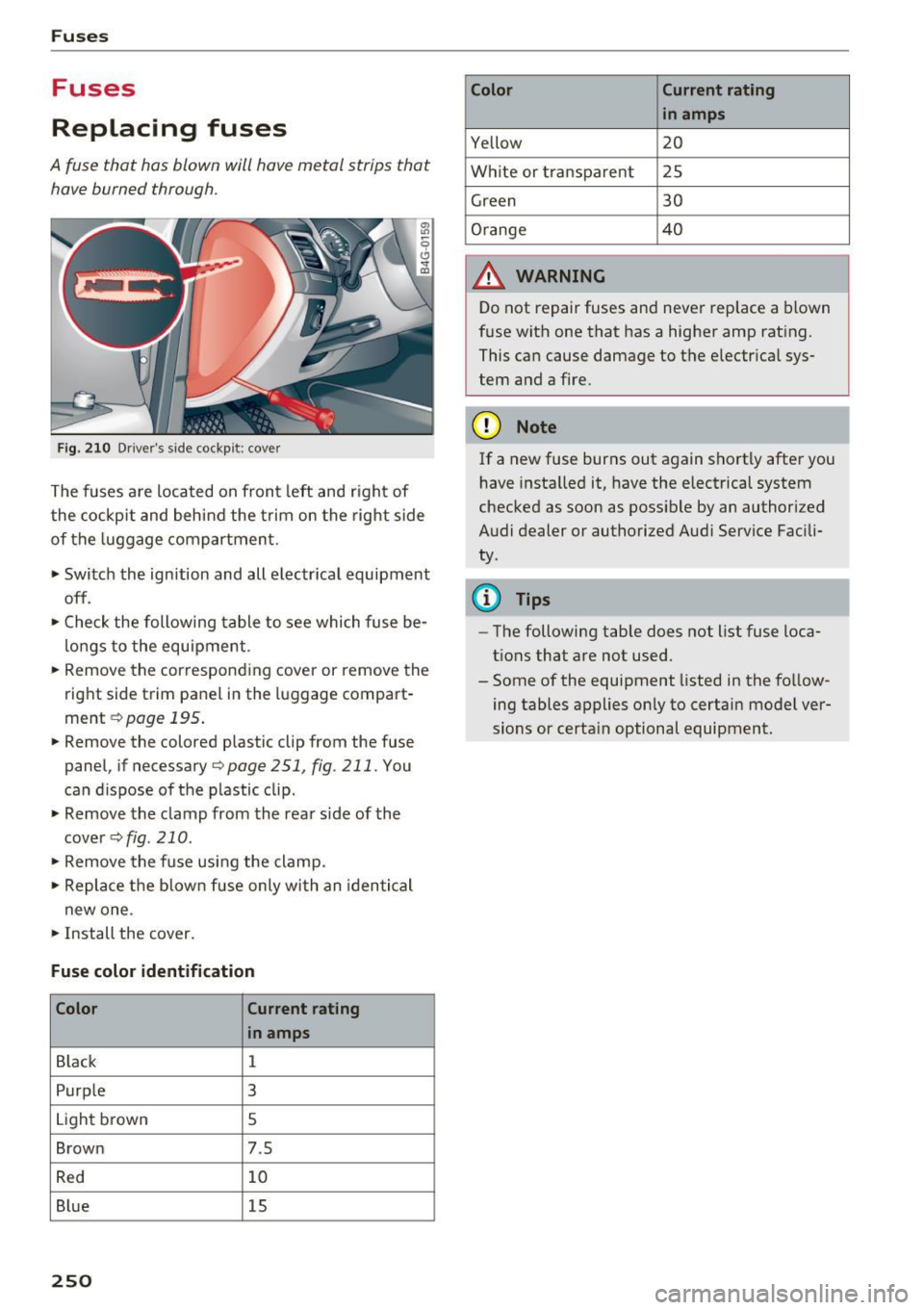
Fuses
Fuses
Replacing fuses
A fuse that has blown will have metal strips that have burned through.
F ig . 21 0 Driver 's side cockpit: cove r
The fuses are located on front left and r ight of
t he cockpit and behind the trim on the rig ht s ide
of the luggage compartmen t.
"' Switch the ignition and all e lectr ica l equipment
off.
"' Che ck the following table to see which fuse be
l o ngs to the equipment.
... Remove the correspond ing cover or remove the
right side trim panel in the l uggage compart
ment
¢ poge 195 .
... Remove the colored plastic clip from the fuse
panel, if necessary
¢page 251, fig. 211. You
can d ispose of the p lastic clip .
... Remove the clamp from the rea r side of the
cove r
¢fig. 210 .
... Remove the fuse usi ng the clamp.
"' Replace t he blow n fu se only wi th an identical
new one.
"' Install the cover.
Fuse color identification
Color Current rating
in amp s
Black 1
Purp le 3
L ight brown 5
B rown 7.5
Red 10
B lue 15
250
Color Current rating
in amps
Yellow 20
Wh ite or transpa rent 25
Green 30
O range 4 0
A WARNING
Do not repair fuses and neve r replace a blown
f u se with one that has a higher amp rat ing.
This can cause damage to the e lectr ica l sys
tem and a fire.
(D Note
If a new fuse burns out again shortly after you
h ave insta lled it, have the e lectrical system
checked as soon as possible by an authorized
Audi dealer or authorized Aud i Service Fac ili
ty.
(D Tips
- The following table does not list fuse loca
t ions that are not used .
- Some of the equipment listed in the fo llow
ing tables applies on ly to certain model ver
sions or certa in optional equipment .
Page 253 of 284

co
co
.... N
" N .... 0
00
<.,;) 'SI"
Driver side cockpit fuse
assignment
Fig. 2 11 Driver side cockp it: fuse panel wit h plastic bracket
Fuse panel @ (black)
No . Equipment
Electromecha nica l powe r steering, trailer
1 hitch, ionizer, switch st
rip, seat heating
(rear), electromechan ica l park ing brake
Ho rn, climate con trol system, Gateway,
2 automati
c dimm ing in ter ior rearv iew m ir-
ro r, On -Board Un it
4 Park ing aid, headlight ra nge adjustment
5
Dynamic steering, E lectron ic Stabilization
Control (ESC)
6 Headlights
7 Adapt ive cruise control
8 Front passenger's seat senso rs, a irbag
9 Gateway
10 Engine sound, night vision ass
ist, garage
door opene r (H ome link), parki ng aid
11 Video camera image processing
1 2 Headlights
13 Steering column sw
itch module
Fuses
Fuse panel @ (black)
14 Termina l 15 (luggage compartment)
15 S tarte r
Fuse panel @ (brown)
No . Equipment
1 Infotainment system
2 Infotainment system
3 Front passenger's seat
5
A
irbag, Elect ronic S tabilization Con trol
( E SC)
6 Ant
i-theft alarm system
7 Electromec hanical pa rking brake
8 Inter io r li ghts
9
Windshie ld video came ra heating, light/
rain sensor
10 Lumbar support (dr iver's seat)
11 Driver
's seat
12 Electronic st abilization con trol
13 Horn
1 4 Head lights
15 Front seat heating
16 Dynam ic steering
Fuse panel © (red)
No . Equipment
1 Clutch peda l
2 Fuel p ump
3 Brake
light sensor
4 AdB lue (diese l engine)/engine aco ustics
5 Rear door
6 Fr
ont door
7 Electronic stab ilization control
8 Windshie ld w iper motor
9 Head light washer system
10 Interio
r lighting, climate control system
1 1 Head lights
12 Sunroof
251
Page 254 of 284
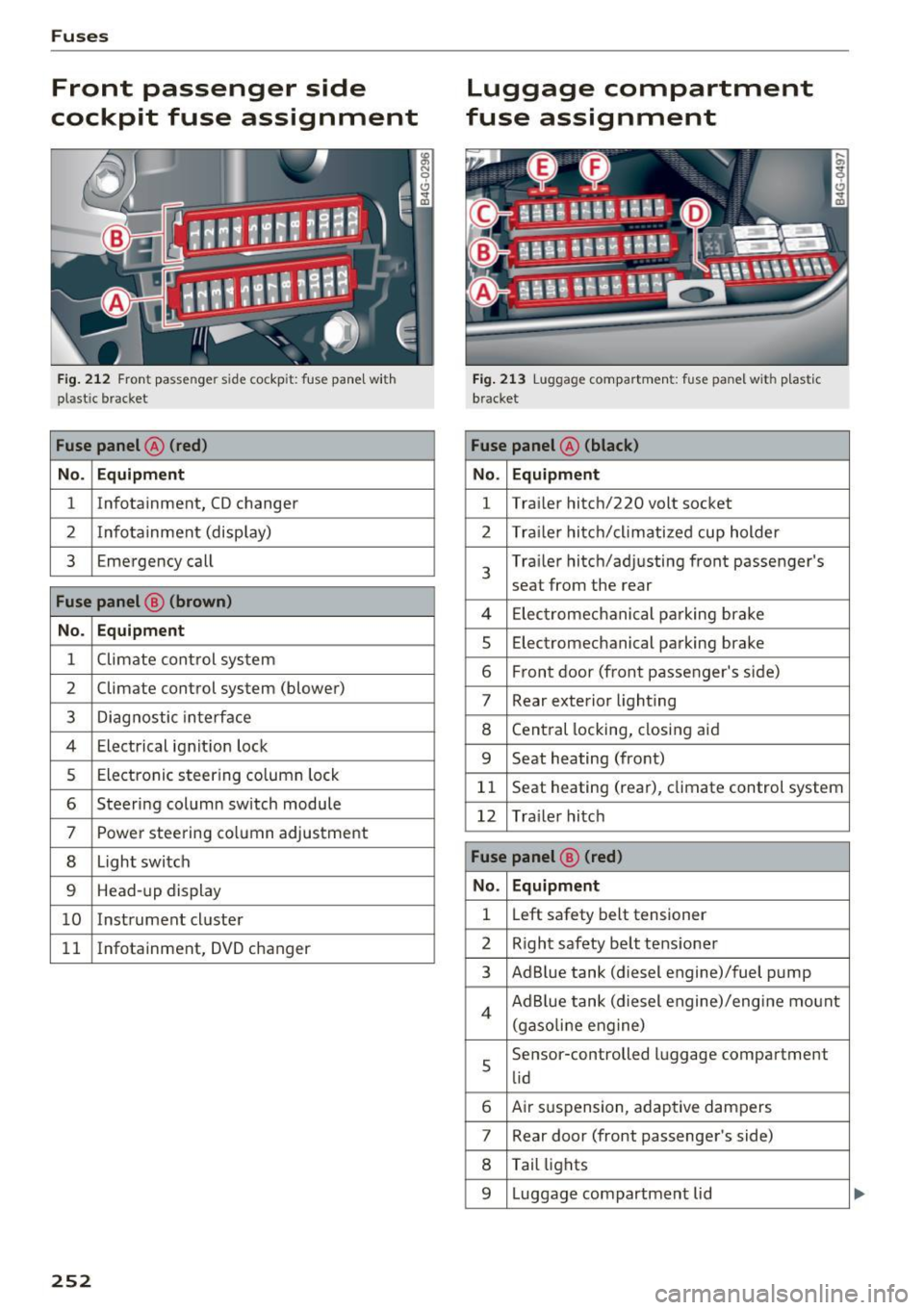
Fuses
Front passenger side
cockpit fuse assignment
Fig. 212 Front passenger side cockpit: fuse panel wit h
plastic bracket
Fuse panel @ (red)
No. Equipm ent
1 Infotainment, CD changer
2 Inf
ota inment (display)
3 Emergency call
Fuse panel @ (brown)
No. Equipment
1 Climate control system
2 Climate control
system (blower)
3 Diagnostic interface
4 Electrical ignit ion lock
5 Electronic steering column lock
6 Steering column switch module
7 Power steering column adjustment
8 Light switch
9 Head-up display
10 Instrument cl uster
11 Infotainment, DVD
changer
252
Luggage compartment
fuse assignment
Fig. 213 Luggage compa rtme nt: fuse panel with plast ic
bracket
Fuse panel @ (black)
No . Equipment
1 Tra
iler hitch/220 volt socket
2 Trailer hitch/climatized cup holder
3
Trailer hitch/adjusting front passenger's
seat from the rear
4 El ec trom echan ical parking brake
5 Electromechanical parking brake
6 Front door (front passenger's side)
7 Rear exterior lighting
8 Central locking, closing aid
9 Seat heating (fro nt)
11 Seat heating
(rear), climate control system
12 Trailer hitch
Fuse panel @ (red)
No. Equipment
1 L
eft safety belt tensioner
2 Right safety belt tensioner
3 Ad Blue tank (diesel engine)/fuel pump
4 Ad Blue tank (diesel engine)/engi ne mount
(gaso lin e eng ine)
5
Se nsor-controlled luggage compartment
lid
6 Air suspension, adaptive dampers
7 Rear door (front passenger's side)
8 Tail lights
9 Luggage compartment lid
Page 255 of 284

co
co
.... N
" N .... 0
00
\.J '
10 Rea r seat enterta inment
12 Rear spo ile r (Sportbac k), s unroof
Fuse panel © (brown)
No . Equipment
1 Infotainment system
2 I nfot ainme nt sys tem
3
Infotainment, automatic d imm ing interior
rearview mirror
4 Rearview camer a/peripheral cameras
5 TV tuner
6 Tank leak detect io n system
7 Sockets
8 Pa rk ing heater
1 0 Lumba r su pport (fro nt passenger 's seat)
1 2 Infotainment system
Fuse panel @ (black)
No. Equipment
Ai r suspe nsion , adaptive d ampe rs , sport
1 d ifferent ia l, elec tromec hanical p arking
b rake
2 Clutch pedal
position sensor/a utomat ic
t ra nsmission
3 Seats
4 Re ar wipe r (Avan t)
5 Side assist
6 Eng ine sound
7 Infotainment/so und amplif ier
8 G ateway
9 Sport diffe rential
1 0 Climate con trol sys te m
1 1 T
ire pressure m onito ring system, park ing
heater
12 Start/S top sys tem
Fuse panel ® (black)
No . Equipment
1 Special purpose vehicles/ rear seats
Fuses
Fuse panel ® (black)
No . Equipment
1 Rear w indow defogge r
253
Page 256 of 284
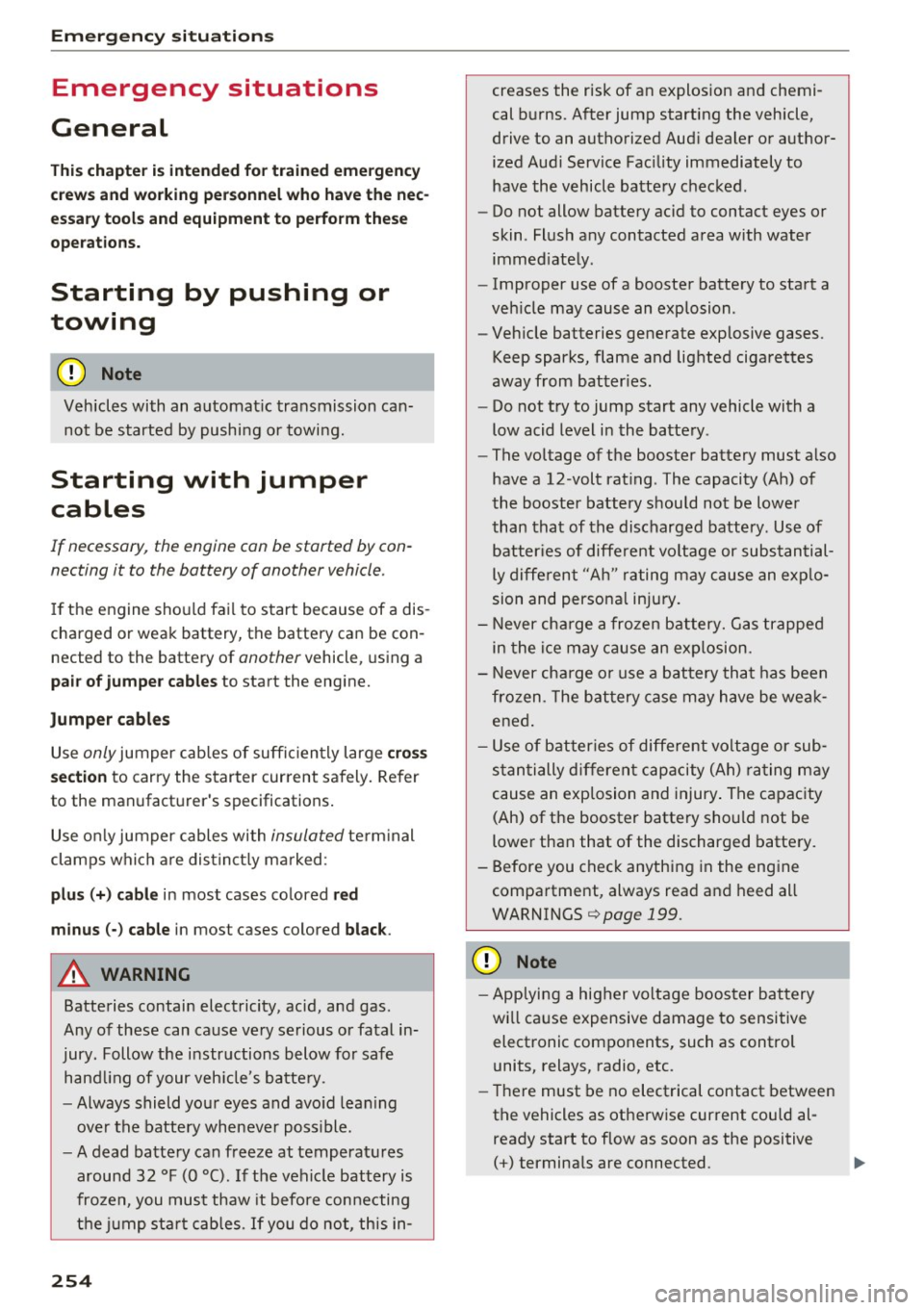
Emergency situations
Emergency situations
General
This chapter is intended for trained emergency
crews and working personnel who have the nec
essary tools and equipment to perform these
operations.
Starting by pushing or
towing
(D Note
Vehicles with an automat ic transmission can
not be started by pushi ng or towing.
Starting with jumper
cables
If necessary, the engine con be started by con
necting it to the battery of another vehicle .
If the engine should fail to start because of a dis
charged or weak battery, the battery can be con
nected to the battery of
another vehicle, using a
pair of jumper cables to start the engine.
Jumper cables
Use only jumper cables of suffic iently large cross
section
to carry the starter current safely. Refer
to the manufacturer's specifications.
Use on ly jumper cables with
insulated term inal
clamps which are distinct ly marked :
plus(+ ) cable in most cases co lored red
minus (-) cable
in most cases colored black .
A WARNING
Batteries contain electricity, acid, and gas.
Any of these can cause very serious or fatal in
jury. Follow the instructions below for safe hand Ling of your veh icle's batte ry .
- Always shield your eyes and avo id leaning
over the battery whenever possible.
- A dead battery can freeze at temperatures
around 32 °F (0 °C). If the vehicle battery is
frozen, you must thaw it before connecting
the jump start cables.
If you do not, this in-
254
creases the risk of an explosion and chemi
cal burns. After jump starting the vehicle,
drive to an authorized Audi dealer or author
ized Audi Service Fac ility immediately to
have the vehicle battery checked.
- Do not allow battery acid to contact eyes or
skin . Flush any contacted area with water
immed iately.
- Improper use of a booster battery to start a
veh icle may cause an explosion .
- Vehicle batteries generate explosive gases.
Keep sparks, flame and lighted cigarettes
away from batter ies .
- Do not try to jump start any vehicle with a
low acid level in the battery .
- The voltage of the booster battery must also
have a 12-volt rat ing. The capacity (Ah) of
the booster battery should not be lower
than that of the discharged battery. Use of
batter ies of different voltage or substantial
ly different "Ah" rating may cause an exp lo
sion and persona l injury.
- Never cha rge a frozen battery. Gas trapped
in the ice may cause an explosion.
- Never cha rge o r use a battery that has been
frozen . The battery case may have be weak
ened.
- Use of batter ies of different voltage or sub
stantially diff erent capacity (Ah) rating may
cause an explosion and injury . The capacity
(Ah) of the booster battery should not be
lower than that of the discharged battery.
- Before you check anything in the engine
compartment, always read and heed all
WARNINGS
r=:> poge 199.
([) Note
-Applying a higher voltage booster battery
will cause expensive damage to sensitive electronic components, such as control
units, relays, radio, etc.
- Th ere must be no electrical contact between
the vehicles as otherwise current could al
ready start to flow as soon as the positive
(+) terminals are connected .
Page 257 of 284
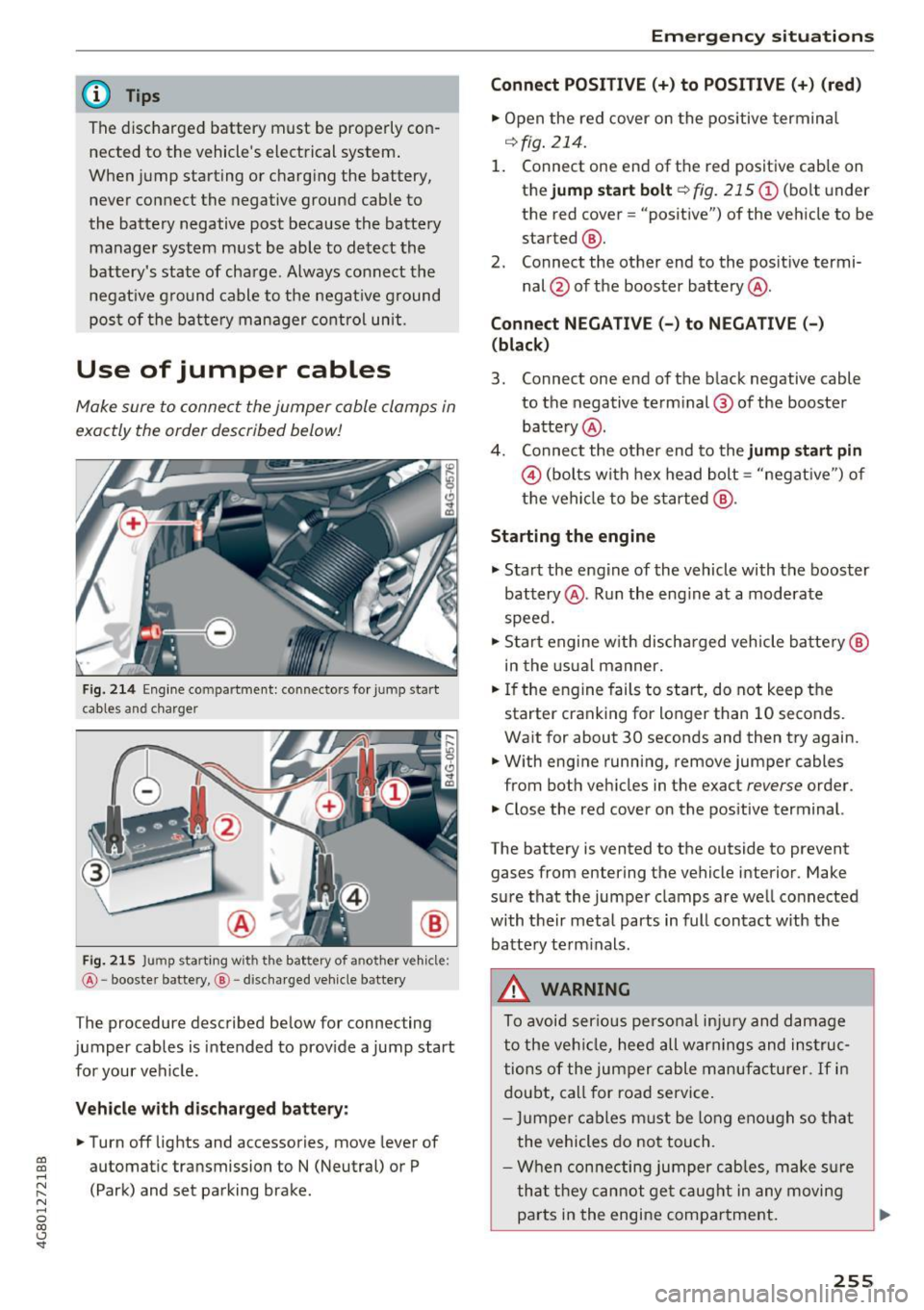
@ Tips
The discharged battery must be properly con
nected to the vehicle's electrical system .
When jump starting or charg ing the battery,
never connect the negative ground cable to
the battery negative post because the battery
manager system must be able to detect the
battery's state of charge. Always connect the
negative ground cable to the negative ground
post of the battery manager control unit.
Use of jumper cables
Make sure to connect the jumper cable clamps in
exactly the order described below!
Fig. 214 Engine compartment: connectors fo r ju mp start
cables and charger
® @
Fig. 215 Jump starting with the battery of another vehicle:
@-booste r battery, @-discharged veh icle batte ry
The procedure described below for connecting
jumper cables is intended to provide a jump start
for your vehicle .
Vehicle with discharged battery:
.. Turn off lights and accessories, move lever of
~ automatic transmission to N (Neutral) or P ....
~ (Park) and set parking brake . N .... 0
00
<.,;) 'SI"
Emergency situations
Connect POSITIVE(+) to POSITIVE (+) (red)
.. Open the red cover on the pos itive terminal
qfig. 214.
1. Connect one end of the red posit ive cab le on
the jump start bolt~
fig. 215 (D (bolt under
the red cover= "positive") of the vehicle to be
started @.
2. Connect the other end to the positive termi- nal@ of the booster battery @.
Connect NEGATIVE (-) to NEGATIVE (-)
(black)
3. Connect one end of the black negative cable
to the negative terminal ® of the booster
battery @.
4. Connect the other end to the jump start pin
@ (bolts with hex head bolt= "negat ive'') of
the vehicle to be started @.
Starting the engine
.. Start the engine of the vehicle with the booster
battery @. Run the eng ine at a moderate
speed .
.. Start engine w ith discharged vehicle battery@
in the usual manner .
.. If the engine fails to start, do not keep the
starter cranking for longer than 10 seconds.
Wait for about 30 seconds and then try again .
.. With engine running, remove jumper cables
from both vehicles in the exact
reverse order .
.. Close the red cover on the positive terminal.
The battery is vented to the outside to prevent gases from entering the vehicle interior . Make
sure that the jumper clamps are well connected
with their metal parts in full contact with the battery terminals .
_&. WARNING
To avoid serious personal injury and damage
to the vehicle, heed all warnings and instruc
tions of the jumper cable manufacturer. If in
doubt, call for road service.
- Jumper cables must be long enough so that
the vehicles do not touch .
- When connecting jumper cables, make sure
that they cannot get caught in any moving
parts in the engine compartment. ..,.
255
Page 258 of 284
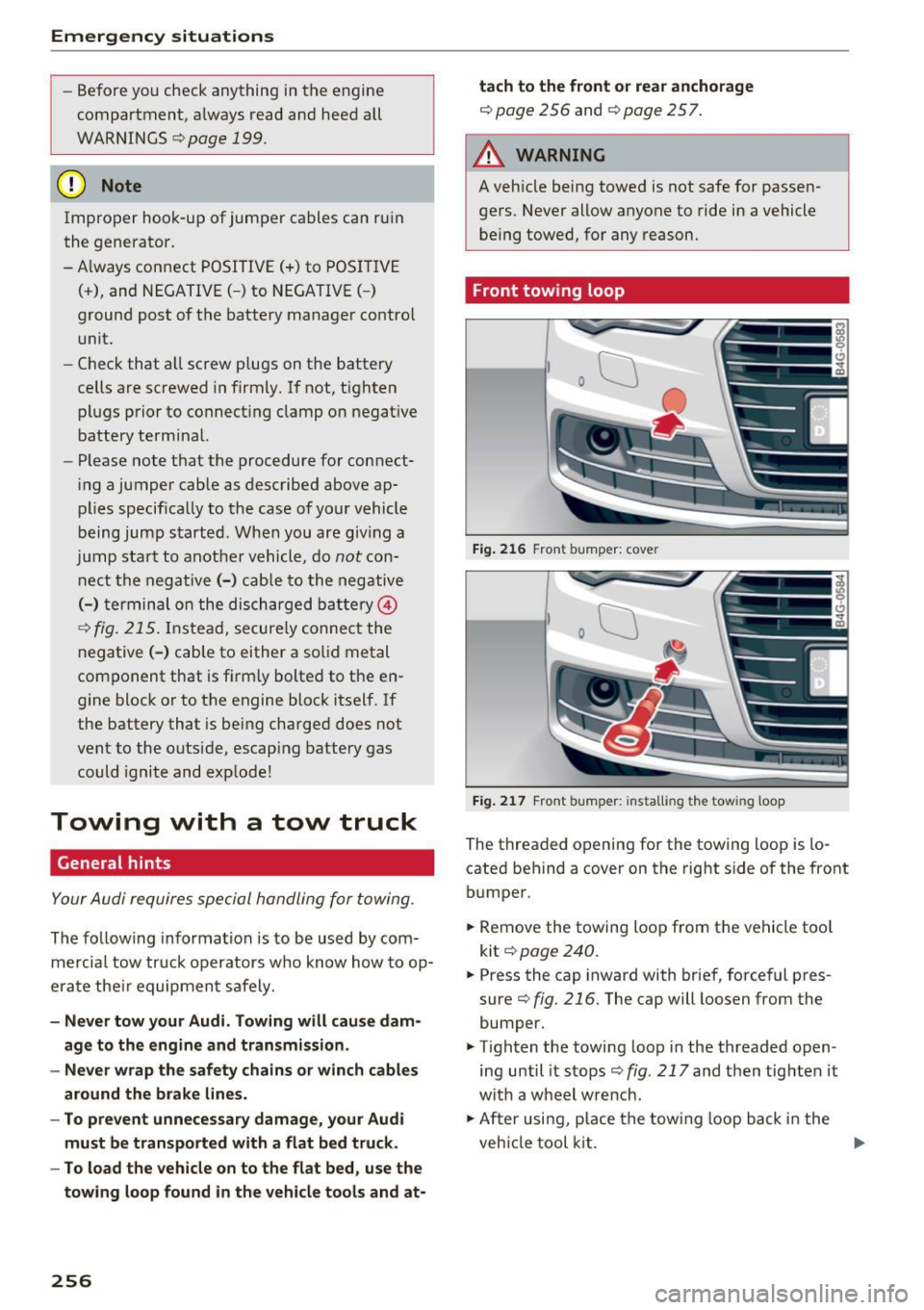
Emergency situations
-Before you check anything in the engine
compartment, always read and heed all
WARNINGS
c> page 199.
(D Note
Improper hook-up of jumper cables can ruin
the generator.
-Always connect POSITIVE(+) to POSITIVE
(+), and NEGATIVE(-) to NEGATIVE(-)
ground post of the battery manager control
unit.
- Check that all screw plugs on the battery
cells are screwed in firmly. If not, tighten
plugs prior to connecting clamp on negative
battery terminal.
- Please note that the procedure for connect
ing a jumper cable as described above ap
plies specifically to the case of your vehicle
being jump started . When you are giving a
jump start to another vehicle, do
not con
nect the negative (-) cable to the negative
(-) terminal on the discharged battery @
c> fig. 215. Instead, securely connect the
negative(-) cable to either a solid metal
component that is firmly bolted to the en
gine block or to the engine block itself. If
the battery that is being charged does not
vent to the outside, escaping battery gas
could ignite and explode!
Towing with a tow truck
General hints
Your Audi requires special handling for towing.
The following information is to be used by com
mercial tow truck operators who know how to op
erate their equipment safely.
- Never tow your Audi. Towing will cause dam
age to the engine and transmission.
- Never wrap the safety chains or winch cables
around the brake lines.
- To prevent unnecessary damage, your Audi
must be transported with a flat bed truck.
- To load the vehicle on to the flat bed, use the
towing loop found in the vehicle tools and at-
256
tach to the front or rear anchorage
c>page 256 and ¢page 257.
A WARNING
A vehicle being towed is not safe for passen
gers . Never allow anyone to ride in a vehicle
being towed, for any reason.
Front towing loop
Fig. 216 Front bumper: cover
Fig. 217 Front bumpe r: install ing the tow ing loop
The threaded opening for the towing loop is lo
cated behind a cover on the right side of the front
bumper .
.. Remove the towing loop from the vehicle tool
kit
c> page 240.
.. Press the cap inward with brief, forceful pres
sure
¢fig. 216. The cap will loosen from the
bumper.
.. Tighten the towing loop in the threaded open
ing until it stops
¢ fig. 217 and then tighten it
with a wheel wrench .
.. After using, place the towing loop back in the
vehicle tool kit.
IJli>
Page 259 of 284
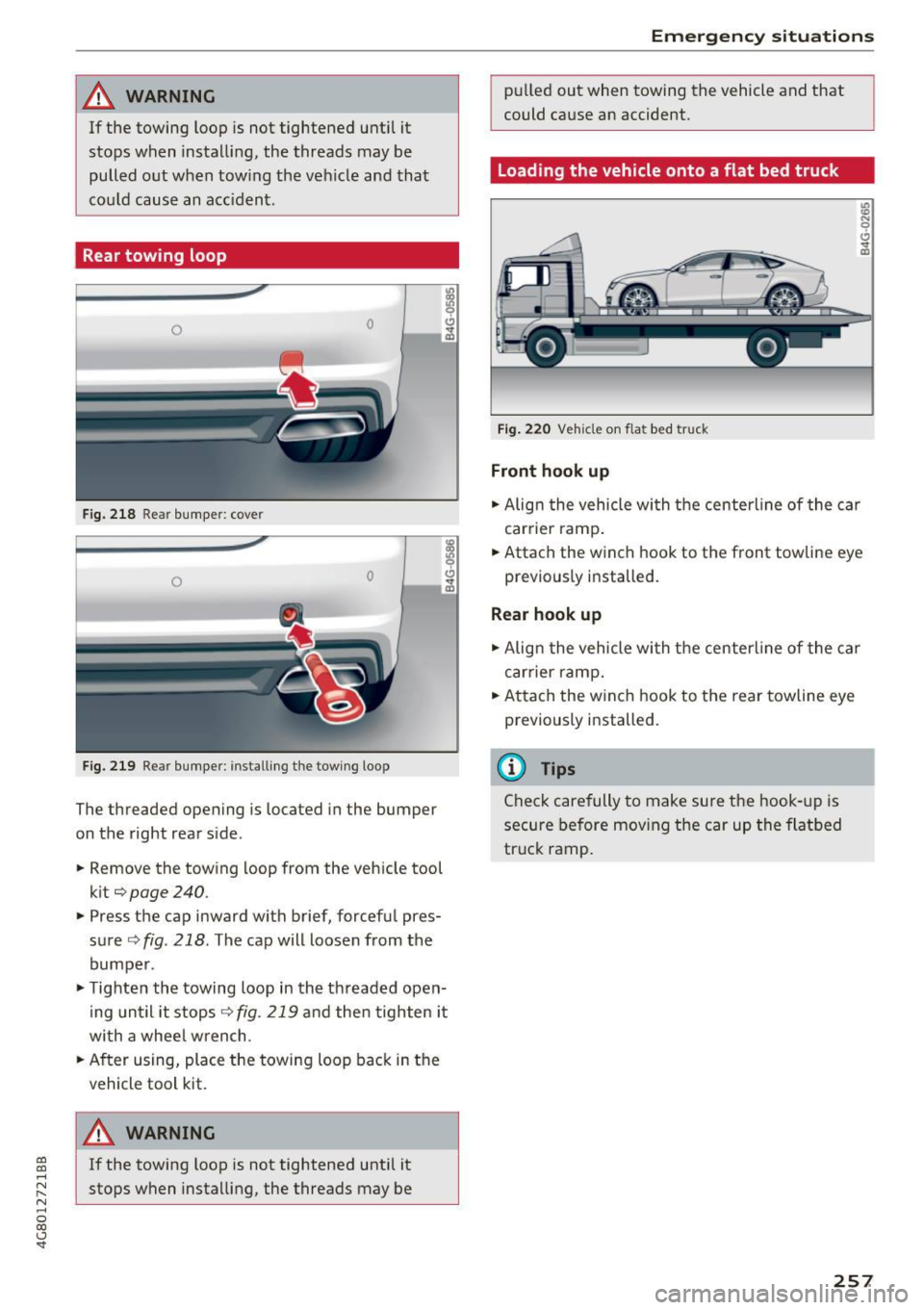
co
co
.... N
" N .... 0
00
<..:l 'SI'
_& WARNING
If the towing loop is not tightened until it
stops when installing, the threads may be
pulled out when tow ing the veh icle and that
could cause an acc ident .
Rear towing loop
0 0
Fig. 218 Rear bumper : cove r
0 0
Fig. 219 Rea
r bumper : installing the towing loop
The threaded opening is located in the bumper
on the right rear side.
.,. Remove the towing loop from the vehicle tool
kit¢
page 240 .
.,. Press the cap inward with brief, forceful pres
sure ¢
fig. 218. The cap will loosen from the
bumper .
.,. Tighten the towing loop in the th readed open
ing until it stops ¢
fig. 219 and then tighten it
with a wheel wrench .
.,. After using, place the towing loop back in the
vehicle tool kit.
_& WARNING
If the towing loop is not tightened until it
stops when installing , the threads may be
-
Emergency situations
pulled out when towing the vehicle and that
could cause an accident.
Loading the vehicle onto a flat bed truck
Fig. 220 Vehicle on flat bed truck
Front hook up
.,. Alig n the vehicle with the centerline of the car
carrier ramp .
.,. Attach the winch hook to the front towline eye
previously installed .
Rear hook up
.,. Align the vehicle with the centerl ine of the car
carrier ramp .
.,. Attach the winch hook to the rear towline eye
previously installed.
(D Tips
Check carefully to make sure the hook-up is
secure before moving the car up the flatbed
truck ramp .
257
Page 260 of 284
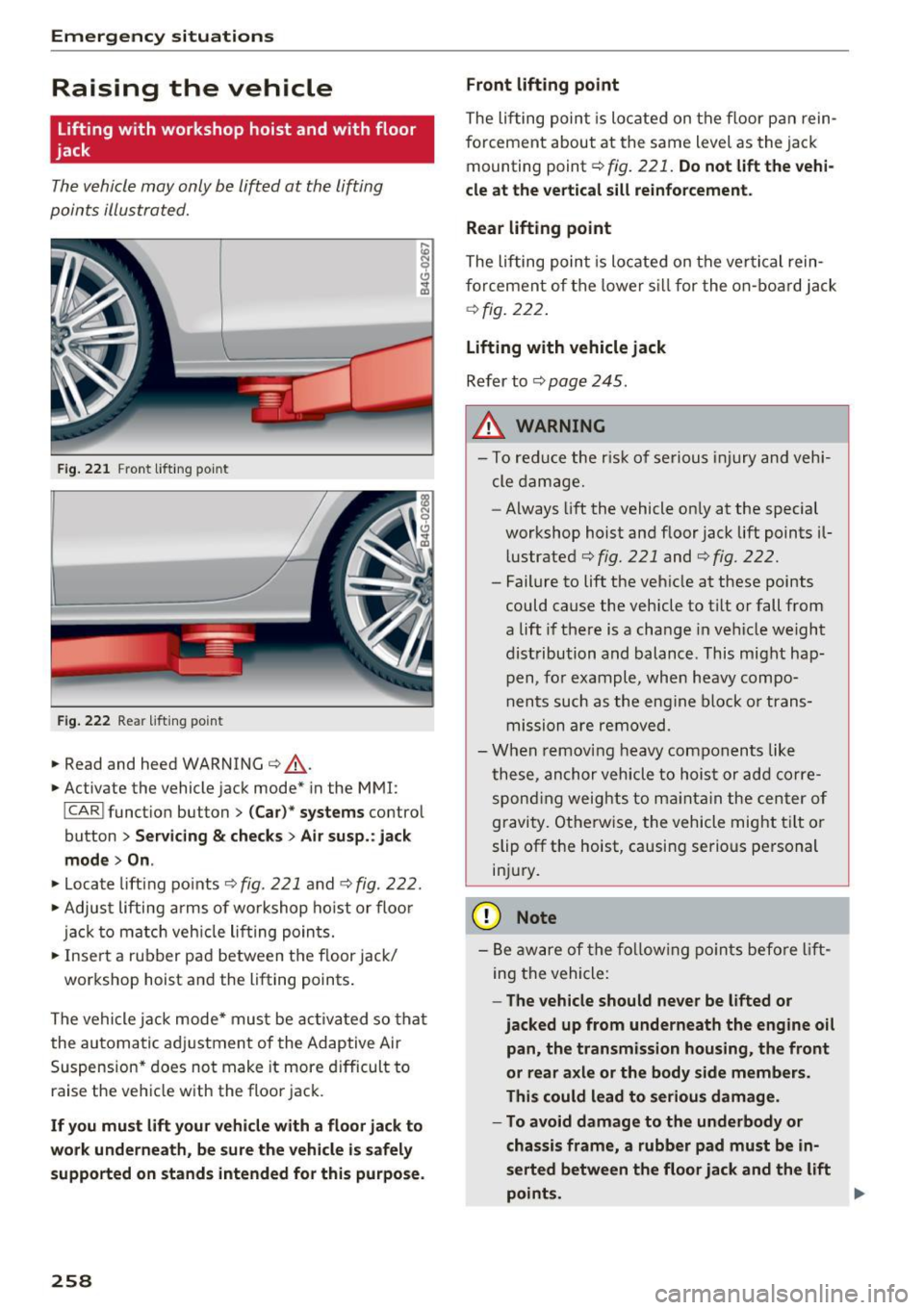
Emergency situations
Raising the vehicle
Lifting with workshop hoist and with floor
jack
Th e vehicle may only b e lift ed at the lifting
poin ts illust rated.
F ig .. 221 F ro nt lift ing po int
F ig. 222 Rea r lifti ng po int
.,. Read and heed WARNING c::> A -
.,. Activate the vehicle jac k mode* in the MMI:
I CAR I funct io n button > (Car) * systems co ntro l
button
> Servicing & checks > Air susp. : jack
mode > On .
.,. Lo ca te lift ing po ints c::> fig . 221 a nd c::> fig . 222 .
.,. Adjus t lifting arms of wo rk shop hoist o r floo r
jac k to m atch veh icle li fting poin ts.
.,. Inse rt a rubber pa d between the floor jack/
wor kshop hoist an d the lifting points .
Th e ve hicle jack mode* must be activa ted so that
the au tom atic a djustment of the Ad aptive Air
S uspens ion* does no t make it more d ifficult to
raise the ve hicle w ith the floor jac k.
If you must lift your vehicle with a floor jack to
work underneath, be sure the vehicle is safely
supported on stands intended for this purpose.
258
Front lifting point
The li fting point is lo cated on the floor pa n rein
f orcement about at the same level as the ja ck
mounting point
c::> fig . 221. Do not lift the vehi
cle at the vertical sill reinforcement.
Rear lifting point
The lif ting poin t is loca ted on the ve rtic al rein
forcement of t he lower sill for the o n-b o ard jack
c::>fig. 22 2.
Lifting with vehicle jack
Refer to c::> page 245 .
A WARNING
-To red uce the r is k of se rious inju ry and vehi
cle damage.
- Always lift the vehicle on ly at the special
workshop hoist an d floor jack lift points il
l ustrated
c::> fig. 221 and c::> fig. 222.
- Fail ure to lift the ve hicle at these points
could cause the vehicle to t ilt o r fall from
a lift i f there is a cha nge in ve hicle we ight
dist ribution and balance . This might hap
pen, fo r example, wh en heavy compo
n en ts such as the eng ine block o r tra ns
m iss ion are re moved .
- Whe n rem oving heavy co m po nents like
t hese, an chor vehicle to hois t or add cor re
s p ondin g weig hts to maintai n the cen ter of
gravi ty . O th erw ise, the vehicle might t ilt or
slip off the hoist, causi ng serio us pers onal
in jur y .
(D Note
- B e aw are of the follo wing p oints bef ore lift
ing the vehicle :
-The vehicle should never be lifted or
jacked up from underneath the engine oil
pan, the transmission housing, the front
or rear axle or the body side members.
This could lead to serious damage .
- To avoid damage to the underbody or
chassis frame, a rubber pad must be in
serted between the floor jack and the lift
points.